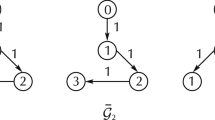Abstract
This paper studies the consensus problem for teleoperation system over communication networks. Compared with previous work, both multi-slave configuration and time variable delays are considered. According to the topology structure of slave robots, centralized and distributed consensus controllers are respectively designed, where a leader-following strategy is adopted. During the design process of distributed controllers, min-weighted rigid graph is used to optimize the topology structure of slave robots. With the optimized topology, the amount of communication links and energy dissipations in slave site can be reduced. Moreover, the sufficient stability conditions are presented to show the consensus controllers can stabilize the master-slave system under variable time delay. Finally, simulation results are performed to show the effectiveness of the main results.
Similar content being viewed by others
References
Alfi, A., Farrokhi, M.: Force reflecting bilateral control of master-slave systems in teleoperation. J. Intell. Robot. Syst. 52(2), 209–232 (2008)
Hashemzadeh, F., Hassanzadeh, I., Alizadeh, G.: Adaptive control for state synchronization of nonlinear haptic telerobotic systems with asymmetric varying time delays. J. Intell. Robot. Syst. 68(3–4), 245–259 (2012)
Nitzsche, N., Schmidt, G.: Force-reflecting telepresence in extensive remote environment. J. Intell. Robot. Syst. 50(1), 3–18 (2007)
Ye, Y., Liu, P.X.: Improving haptic feedback fidelity in wavevariable-based teleoperation oriented to telemedical applications. IEEE Trans. Instrum. Meas. 58(8), 2847–2855 (2009)
Polushin, I.G., Liu, P.X., Lung, C.H.: A control scheme for stable force-reflecting teleoperation over IP networks. IEEE Trans. Syst. Man Cybern. B 36(4), 930–939 (2006)
Hua, C.C., Liu, P.X.: Teleoperation over the internet with/without velocity signal. IEEE Trans. Instrum. Meas. 60(1), 4–13 (2011)
Yang, X., Hua, C.C., Yan, J., Guan, X.P.: New stability criteria for networked teleoperation system. Inf. Sci. 233(1), 244–254 (2013)
Nuño, E., Basañez, L., Ortega, R., Spong, M.W.: Position tracking for non-linear teleoperators with variable time delay. Int. J. Robot. Res. 28(7), 895–910 (2009)
Polushin, I.G., Liu, P.X., Lung, C.H.: Stability of bilateral teleoperators with generalized projection-based force reflection algorithms. Automatica 48(6), 1005–1016 (2012)
Xu, Z.H., Ma, L., Wu, Z.Y., Schilling, K., Necsulescu, D.: Teleoperating a formation of car-like rovers under time delays. In: Processing of Chinese Control Conference, pp. 4095–4101 (2011)
Rodríguez-Seda, E.J., Troy, J.J., Erignac, C.A., Murray, P., Stipanović, D.M., Spong, M.W.: Bilateral teleoperation of multiple mobile agents: coordinated motion and collision avoidance. IEEE Trans. Control Syst. Technol. 18(4), 984–992 (2010)
Couzin, I.D., Krause, J., Franks, N.R., Levin, S.A.: Effective leadership and decision-making in animal groups on the move. Nature 433(7025), 513–516 (2005)
Hong, Y.G., Chen, G.R., Bushnell, L.: Distributed observers design for leader-following control of multi-agent networks. Automatica 44(3), 846–850 (2008)
Su, H.S., Wang, X.F., Lin, Z.L.: Flocking for multi-agents with a virtual leader. IEEE Trans. Autom. Control. 54(2), 293–307 (2009)
Olfati-Saber, R.: Flocking for multi-agent dynamic systems: algorithms and theory. IEEE Trans. Autom. Control. 51(3), 401–420 (2006)
Jadbabaie, A., Lin, J., Morse, A.S.: Coordination of groups of mobile autonomous agents using nearest neighbor rules. IEEE Trans. Autom. Control. 48(6), 988–1001 (2003)
Bai, H., Wen, J.T.: Cooperative load transport: a formation-control perspective. IEEE Trans. Robot. 26(4), 742–750 (2010)
Anderson, B.D., Yu, C., Fidan, B., Hendrickx, J.: Rigid graph control architectures for autonomous formations. IEEE Control. Syst. Mag. 28(6), 48–63 (2008)
Eren, T., Anderson, B.D., Morse, A.S., Whiteley, W., Belhumeur, P.N.: Operations on rigid formations of autonomous agents. Commun. Inf. Syst. 3(4), 223–258 (2004)
Yu, C., Hendrickxc, J.M., Fidana, B., Anderson, B.D., Blondel, V.D.: Three and higher dimensional autonomous formations: rigidity, persistence and structural persistence. Automatica 43(3), 387–402 (2007)
Luo, X.Y., Li, S.B., Guan, X.P.: Automatic generation of minweighted persistent formations. Chin. Phys. B 18(8), 3104–3114 (2009)
Kelly, R., Santibáñez, V., Loria, A.: Control of Robot Manipulators in Joint Space. Springer, New York (2005)
Godsil, C., Royle, G.: Algebraic Graph Theory. Springer, New York (2001)
Beard, R.W., Stepanyan, V.: Information consensus in distributed multiple vehicle coordinated control. In: Processing of IEEE Control and Decision Conference, pp. 2029–2034 (2003)
Heinzelman, W.B., Chandrakasan, A.P., Balakrishnan, H.: An application-specific protocol architecture for wireless microsensor networks. IEEE Trans. Wirel. Commun. 1(4), 660–670 (2002)
Merlin, C.J., Heinzelman, W.B.: Duty cycle control for low-power-listening MAC protocols. IEEE Trans. Mob. Comput. 9(11), 1508–1521 (2010)
Author information
Authors and Affiliations
Corresponding author
Rights and permissions
About this article
Cite this article
Yan, J., Luo, X., Yang, X. et al. Consensus of Multi-slave Bilateral Teleoperation System with Time-Varying Delays. J Intell Robot Syst 76, 239–253 (2014). https://doi.org/10.1007/s10846-014-0023-z
Received:
Accepted:
Published:
Issue Date:
DOI: https://doi.org/10.1007/s10846-014-0023-z




